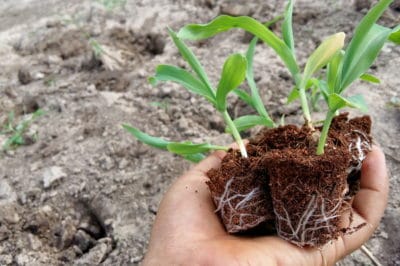Know Your Planting Zone
Before you can plant your corn crop, you need to know in which growing zone you live. The time frame for growing corn is dependent on where you live. For example, if you live in a region with a long growing season, you will plant corn at a different time than if you live in an area with a short growing season.
Tip: To find out what your growing zone is, you can visit the USDA website, call your local home and garden center, or even ask an experienced gardener.
Things to Do Before Planting
Before you start planting your corn, you need to be sure the ground is ready. It takes more than some dirt, seeds, and water to grow a healthy crop of corn.
Corn does not grow well in clay-like or sandy soil. If your garden has an abundance of either of these, you need to amend the soil before planting. One of the best ways to do this is to work well-composted material into the earth and let it overwinter. Then, when spring arrives, pre-treat the soil with an organic fertilizer that is high in nitrogen.
Additionally, you should also take note of the following before deciding where to plant the corn:
- Corn requires full sunlight. Six hours of sun is the bare minimum, so be sure to plant well away from trees or homes that may prevent the sun from shining directly on the corn.
- Corn is a heavy feeder. You will need to fertilize at least three times during the season with a nitrogen-rich organic fertilizer.
- Corn needs a lot of water. If you live in an area with hot, dry summers, plan on watering st least twice weekly.
Tip: Corn does provide shade for some plants that do not need full sunlight. Plant shade-tolerant plants close to your corn crop.
Monitor Soil Temperature and Weather
Just because the air is getting warmer and feels like spring does not mean it is time to plant your corn. Corn is not cold tolerant, and the soil needs to be between 60-65°F (16-18°C) before your corn seeds can germinate.
If you have not been gardening long, resist the temptation to gauge the soil temperature by feel. Instead, invest in a soil thermometer to guarantee it is warm enough to plant your corn seeds.
Generally speaking, the earth warms up about two weeks after the last frost date for your area. Watching the weather carefully can help you determine when to start testing the temperature of your garden plot.
Tip: If you live in a short growing season, you can cover the ground with black plastic to help the earth warm up more quickly.
Planting Time
Once you have amended your soil properly and planned where to plant the corn, you can safely put your seeds in the ground as soon as it has warmed. If you did not have the chance to pre-treat your soil with fertilizer, plan to do so as soon as the corn plants are about three inches (7.5 cm) tall.
Whether you are growing sweet corn for eating fresh or canning or field corn to make cornmeal or animal feed, the time frame for when to plant corn is the same. As long as you do not plant the corn too soon, you should be able to harvest a bumper crop.
